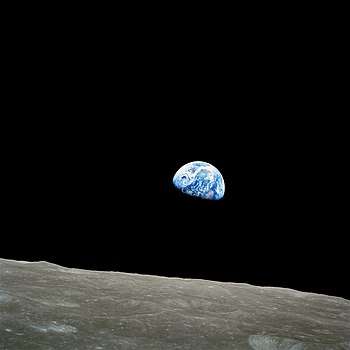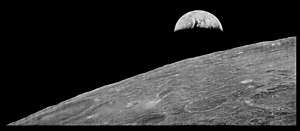Earthrise
Earthrise is a photograph of Earth and some of the Moon's surface that was taken from lunar orbit by astronaut William Anders on December 24, 1968, during the Apollo 8 mission.[1][2][3] Nature photographer Galen Rowell declared it "the most influential environmental photograph ever taken".[4]


Anders' color image had been preceded by a crude black-and-white 1966 raster image taken by the Lunar Orbiter 1 robotic probe, the first American spacecraft to orbit the Moon.
Details
Earthrise is the name popularly given to NASA image AS08-14-2383, taken by astronaut William Anders during the Apollo 8 mission, the first crewed voyage to orbit the Moon.[4][5]
Initially, before Anders found a suitable 70 mm color film, mission commander Frank Borman said he took a black-and-white photograph of the scene, with the Earth's terminator touching the horizon (AS08-13-2329). The land mass position and cloud patterns in this image are the same as those of the color photograph entitled Earthrise.[6]
The photograph was taken from lunar orbit on December 24, 1968, 16:00 UTC,[7] with a highly modified Hasselblad 500 EL with an electric drive. The camera had a simple sighting ring rather than the standard reflex viewfinder and was loaded with a 70 mm film magazine containing custom Ektachrome film developed by Kodak. Immediately prior, Anders had been photographing the lunar surface with a 250 mm lens; the lens was subsequently used for the Earthrise images.[8] An audio recording of the event is available[9] with transcription[10] which allows the event to be followed closely – excerpt:[11]
Anders: Oh my God! Look at that picture over there! There's the Earth coming up. Wow, that's pretty.
Borman: Hey, don't take that, it's not scheduled. (joking)[1]
Anders: (laughs) You got a color film, Jim?
Hand me that roll of color quick, would you...
Lovell: Oh man, that's great!
There were many images taken at that point. The mission audio tape establishes several photographs were taken, on Borman's orders, with the enthusiastic concurrence of Jim Lovell and Anders. Anders took the first color shot, then Lovell who notes the setting (1/250th of a second at f/11), followed by Anders with another very similar shot (AS08-14-2384).
A nearly full-page black and white reproduction of Borman's image may be viewed on page 164 of his 1988 autobiography, captioned, "One of the most famous pictures in photographic history – taken after I grabbed the camera away from Bill Anders". Borman was the mission commander and notes that this is the image "the Postal Service used on a stamp, and few photographs have been more frequently reproduced".[12]:212 The photograph reproduced in the Frank Borman autobiography is not the same image as the Anders photograph; aside from the orientation, the cloud patterns differ. Borman later recanted this story and agreed that the black and white shot was also taken by Anders, based on evidence presented by transcript and a video produced by NASA Goddard Space Flight Center Scientific Visualization Studio employee, Ernie Wright.[8]
The stamp issue reproduces the cloud, color, and crater patterns of the Anders picture. Anders is described by Borman as holding "a masters degree in nuclear engineering"; Anders was thus tasked as "the scientific crew member ... also performing the photography duties that would be so important to the Apollo crew who actually landed on the Moon".[12]:193
On the 50th anniversary of the Apollo 8 mission in 2018, Anders described in an interview how the image undermined his religious belief: "It really undercut my religious beliefs. The idea that things rotate around the pope and up there is a big supercomputer wondering whether Billy was a good boy yesterday? It doesn't make any sense. I became a big buddy of [atheist scientist] Richard Dawkins."[13]
Geometry
.jpg)
William Anders' first color Earthrise photo, in its orientation as seen by the crew of Apollo 8. Lunar north is up.
The as-taken image was rotated 90 degrees clockwise to produce the iconic published Earthrise orientation because the original image did not convey the sense of the Earth rising over the moonscape. The as-published photograph shows Earth:
- Polar orientation: south to left, north to right (Antarctica at 10 o'clock)
- Equator: centre, running westward toward top right-hand corner
- Nightfall terminator crossing the African continent (lightish region to left is Namib Desert, Namibia; to right is Western Sahara/West Africa)
- Rotated clockwise approximately 135° from our typical North/South-Pole-oriented perspective
Legacy
In Life's 100 Photographs that Changed the World, wilderness photographer Galen Rowell called Earthrise "the most influential environmental photograph ever taken".[15][16] Another author called its appearance the beginning of the environmental movement.[17] Fifty years to the day after taking the photo, William Anders observed, "We set out to explore the moon and instead discovered the Earth."[18]
In October 2018, the Working Group for Planetary System Nomenclature (WGPSN) of the International Astronomical Union named two of the craters seen in the photo Anders' Earthrise and 8 Homeward. The craters had previously been designated only with letters.[19]
Joni Mitchell sings on "Refuge of the Roads": In a highway service station / Over the month of June / Was a photograph of the Earth / Taken coming back from the Moon / And you couldn't see a city / On that marbled bowling ball / Or a forest or a highway / Or me here least of all …
Stamp

In 1969, the U.S. Postal Service issued a stamp (Scott# 1371) commemorating the Apollo 8 flight around the Moon. The stamp featured a detail (in color) of the Earthrise photograph, and the words, "In the beginning God...", recalling the Apollo 8 Genesis reading.[20]
2008 video
On April 6, 2008 (Japan Standard Time), the first 1080p high-definition Earthrise video was captured, both a full Earthrise and Earthset video, by the JAXA lunar orbiter mission, SELENE (better known in Japan by its nickname Kaguya). After successfully orbiting the Moon for 1 year and 8 months, it was crashed intentionally onto the lunar surface at 18:25 UTC on June 10, 2009.[21]
2013 simulation video
In 2013, in commemoration of the 45th anniversary of the Apollo 8 mission, NASA issued a video about the taking of the photograph.[22] This computer-generated visualization used data from the Lunar Reconnaissance Orbiter spacecraft, which had provided detailed images of the lunar surface that could be matched with those taken every 20 seconds by an automatic camera on Apollo 8. The resulting video, re-creating what the astronauts would have seen (rotated 90 degrees clockwise to match the perspective presented in the photograph), was synchronized with the recording of the crew's conversation as they became the first humans to witness an Earthrise. The video included explanatory narration written and read by Andrew Chaikin.[23] Chaikin writes that all the photographs of the rising Earth on Apollo 8's fourth orbit were taken by Anders.[24]
Potential earthrises as seen from the Moon's surface

The Earth "rose" because the spacecraft was traveling over the Moon's surface. An earthrise that might be witnessed from the surface of the Moon would be quite unlike moonrises on Earth. Because the Moon is tidally locked with the Earth, one side of the Moon always faces toward Earth. Interpretation of this fact would lead one to believe that the Earth's position is fixed on the lunar sky and no earthrises can occur; however, the Moon librates slightly, which causes the Earth to draw a Lissajous figure on the sky. This figure fits inside a rectangle 15°48' wide and 13°20' high (in angular dimensions), while the angular diameter of the Earth as seen from Moon is only about 2°. This means that earthrises are visible near the edge of the Earth-observable surface of the Moon (about 20% of the surface). Since a full libration cycle takes about 27 days, earthrises are very slow, and it takes about 48 hours for Earth to clear its diameter.[25] During the course of the month-long lunar orbit, an observer would additionally witness a succession of "Earth phases", much like the lunar phases seen from Earth. That is what accounts for the half-illuminated globe, the ashen glow, seen in the photograph.
See also
- Earth phase
- Pale Blue Dot
- Pale Orange Dot (Early Earth)
- The Blue Marble
References
- "Chasing the Moon: Transcript, Part Two". American Experience. PBS. 10 July 2019. Retrieved 24 July 2019.
- Overbye, Dennis (21 December 2018). "Apollo 8's Earthrise: The Shot Seen Round the World - Half a century ago today, a photograph from the moon helped humans rediscover Earth". The New York Times. Retrieved 24 December 2018.
- Boulton, Matthew Myer; Heithaus, Joseph (24 December 2018). "We Are All Riders on the Same Planet - Seen from space 50 years ago, Earth appeared as a gift to preserve and cherish. What happened?". The New York Times. Retrieved 25 December 2018.
- Rowell, Galen. "The Earthrise Photograph". Australian Broadcasting Corporation.
- Nemiroff, R.; Bonnell, J., eds. (December 14, 2005). "Earthrise". Astronomy Picture of the Day. NASA.
- Poole, Robert (2008). Earthrise: How Man First Saw the Earth. New Haven, Connecticut, USA: Yale University Press. ISBN 0-300-13766-4.
- The mission transcript (day 4, p. 114) shows the shot taken at 03 03 49 (mission time 3d3h49), and the launch was on 1968-12-21 12:51 UTC.
- Chaikin, Andrew (January–February 2018). "Who Took the Legendary Earthrise Photo From Apollo 8?". Smithsonian.
- "NASA audio tape encoded in MP3". PBS.
- "Apollo 8 Command Module audio transcription" (PDF). JSC.NASA.gov.
- "Earthrise 45th Anniversary (NASA Goddard analysis)". YouTube.
- Borman, Frank (1988). Countdown: An Autobiography. New York, NY, USA: Morrow (Silver Arrow Books). ISBN 0-688-07929-6.
- Earthrise: how the iconic image changed the world The Guardian, 2018-12-24.
- "Earthrise - Apollo 8". NASA on The Commons. NASA – via Flickr.
- Rowel, Galen. "100 Photographs that Changed the World by Life". The Digital Journalist.
- Widmer, Ted (24 December 2018). "What Did Plato Think the Earth Looked Like? - For millenniums, humans have tried to imagine the world in space. Fifty years ago, we finally saw it". The New York Times. Retrieved 25 December 2018.
- Wilford, John Noble (July 14, 2009). "On Hand for Space History, as Superpowers Spar". The New York Times. Retrieved April 24, 2011.
- Anders, Bill (December 24, 2018). "50 Years After 'Earthrise,' a Christmas Eve Message from Its Photographer". Space.com. Retrieved December 24, 2018.
- Schulz, Rita. "Lunar craters named in honor of Apollo 8". EurekAlert!. International Astronomical Union. Retrieved October 7, 2018.
- "Apollo 8 Issue – Postal Bulletin: March 27, 1969". Smithsonian National Postal Museum. Archived from the original on February 2, 2016. Retrieved April 28, 2020.
- KAGUYA (SELENE)Image Taking of "Full Earth-Rise" by HDTV April 11, 2008 (JST), Japan Aerospace Exploration Agency (JAXA),Japan Broadcasting Corporation (NHK)
- NASA. "45th anniversary of the Earthrise Photo". YouTube.
- Steigerwald, Bill (December 20, 2013). "NASA Releases New Earthrise Simulation Video". National Aeronautics and Space Administration. Retrieved December 22, 2013.
- Chaikin, Andrew. "Who Took the Legendary Earthrise Photo From Apollo 8?". Smithsonian. Retrieved July 27, 2018.
- Makowiecki, Piotr (1985). Pomyśl zanim odpowiesz (in Polish). Warszawa: Państwowe Wydawnictwo "Wiedza Powszechna". ISBN 83-214-0419-7.
External links
| Wikimedia Commons has media related to Earthrise. |
- Earthrise: The 45th Anniversary (NASA Goddard, YouTube channel)
- Earthrise: The 45th Anniversary – NASA Goddard webpage with various reconstruction videos
- Lunar Reconnaissance Orbiter, reconstruction video of the Earthrise photograph
